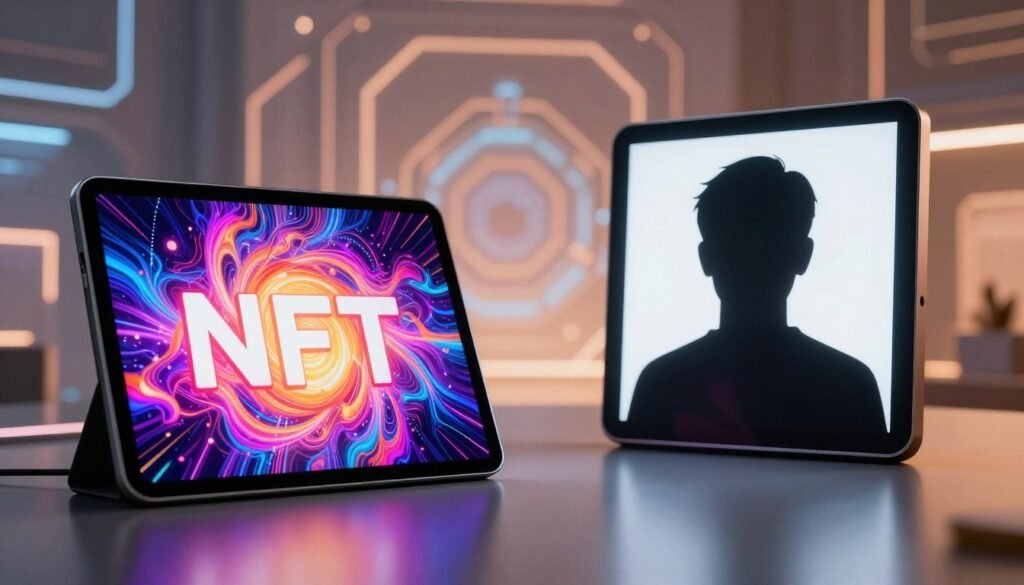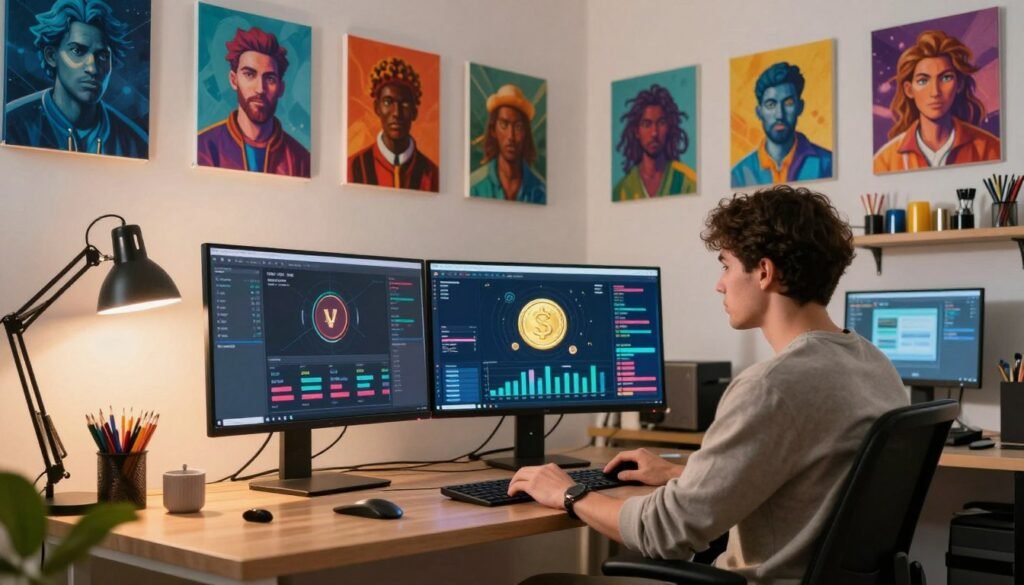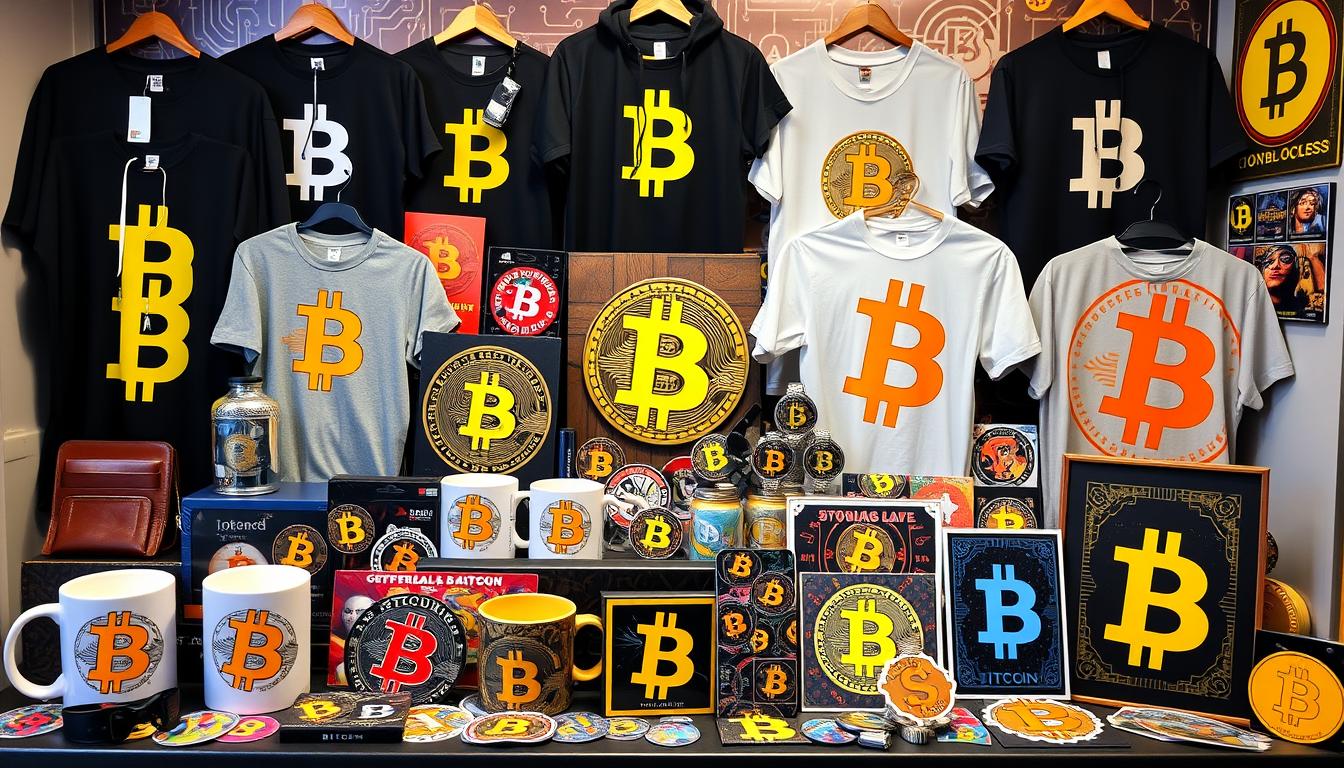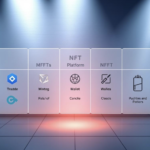Now Reading: NFTs for Digital Fashion Ownership: Ultimate Guide 2024
- 01
NFTs for Digital Fashion Ownership: Ultimate Guide 2024
NFTs for Digital Fashion Ownership: Ultimate Guide 2024
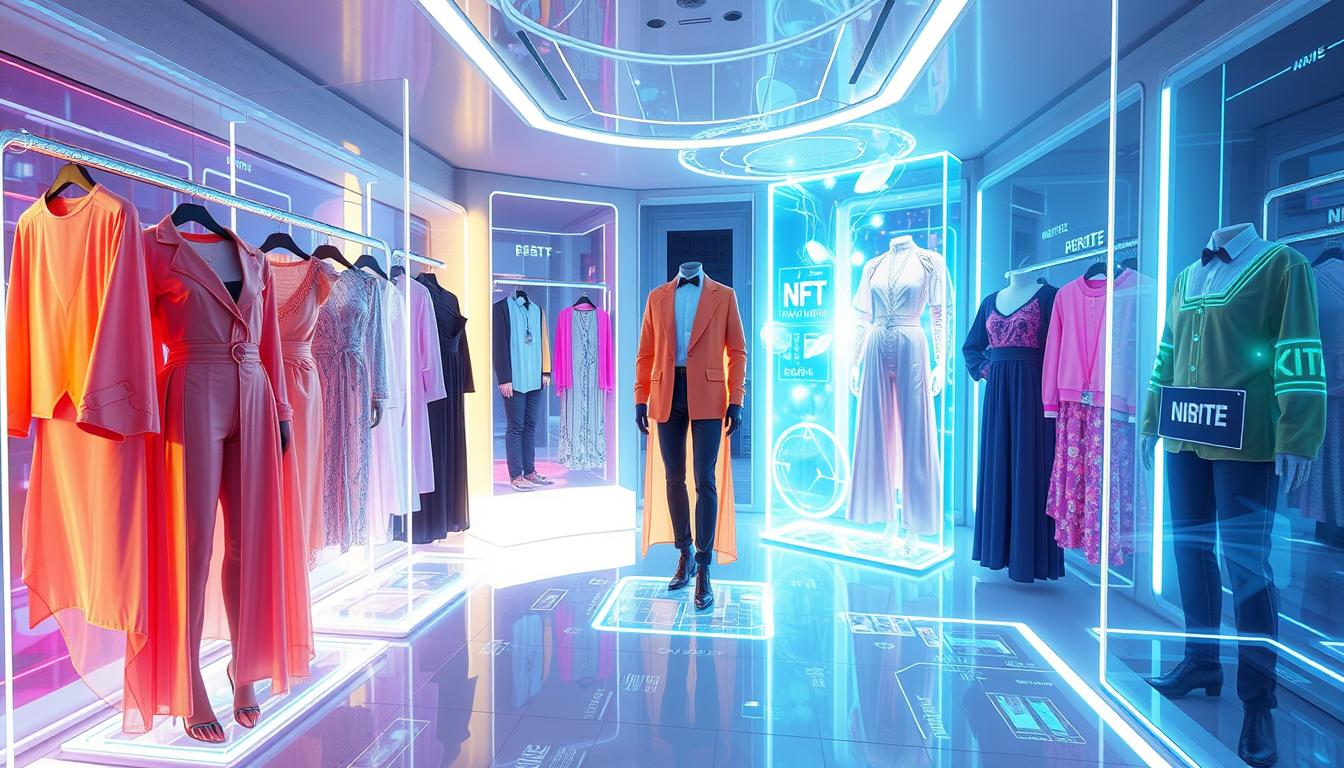
In the ever-evolving landscape of fashion, a new era of digital ownership has emerged, driven by the revolutionary impact of Non-Fungible Tokens (NFTs). This comprehensive guide delves into the transformative role of NFTs in the digital fashion industry, exploring the key concepts, market trends, and future prospects for 2024. Blockchain technology is rapidly reshaping the fashion landscape, enabling authentic ownership of virtual garments and creating unprecedented opportunities for designers, brands, and consumers alike.
The intersection of NFTs and fashion has unlocked a new frontier of creative expression and value creation. This guide will take you on a journey through the dynamic world of digital fashion ownership, empowering you with the knowledge to navigate this rapidly evolving landscape. From understanding the fundamentals of NFTs to exploring the benefits for fashion businesses and consumers, this ultimate guide will equip you with the insights needed to thrive in the era of digital fashion ownership.
Key Takeaways
- Discover the transformative impact of NFTs on the fashion industry, enabling authentic digital ownership of virtual garments
- Explore the key benefits of NFTs for fashion designers, brands, and consumers, including new revenue streams and enhanced brand loyalty
- Understand the role of blockchain technology in revolutionizing fashion ownership and provenance
- Gain insights into the evolving legal landscape and regulatory considerations surrounding digital fashion NFTs
- Learn about successful case studies and the future trends shaping the digital fashion and NFT ecosystem
Introduction to NFTs and Digital Fashion
In the ever-evolving world of fashion, a new era has dawned with the rise of NFTs (Non-Fungible Tokens) and the growing prominence of digital garments. These innovative technologies are poised to reshape how we perceive, own, and interact with fashion.
What are NFTs?
At their core, NFTs are unique, digital assets stored on a blockchain network. Unlike traditional digital items that can be easily replicated, each NFT is one-of-a-kind, providing a verifiable record of ownership and authenticity. This revolutionary concept has opened up new possibilities for the fashion industry, allowing designers and brands to create truly exclusive digital fashion pieces.
Overview of Digital Fashion
The world of digital fashion encompasses a wide range of virtual garments, accessories, and even entire outfits. These crypto couture items exist solely in the digital realm, often created using advanced 3D modeling and animation techniques. Consumers can purchase and wear these digital assets in various virtual spaces, from online games to social media platforms, allowing for a new level of self-expression and personal style.
The Intersection of NFTs and Fashion
The marriage of NFTs and fashion has sparked a revolution in the industry. By leveraging the unique properties of NFTs, designers and brands can now offer digital fashion items that are truly one-of-a-kind, with provable scarcity and authenticity. This not only creates new revenue streams but also fosters a deeper connection between consumers and the brands they love, as they can now own and display digital fashion pieces as a means of personal expression and status.
As the industry continues to evolve, the intersection of NFTs and digital fashion is poised to transform the way we approach fashion ownership, consumption, and the overall fashion landscape. This guide will delve deeper into the implications and opportunities presented by this exciting new frontier.
The Rise of Digital Fashion
The fashion industry has a rich history of embracing technological advancements. From early computer-aided design tools to the modern era of immersive virtual experiences, the relationship between fashion and technology has continued to evolve. This evolution has led to the rise of digital fashion assets, which are transforming the way we approach virtual clothing and metaverse apparel.
Historical Context of Fashion and Technology
The integration of technology and fashion dates back to the 1970s, when designers began experimenting with computer-aided design (CAD) software to create digital fashion prototypes. As the digital revolution gained momentum, the fashion industry quickly recognized the potential of technology to enhance the creative process and streamline production.
The Impact of Social Media on Digital Fashion
The rise of social media platforms, such as Instagram and TikTok, has been a significant catalyst in the adoption of digital fashion assets. These platforms have provided a global stage for fashion enthusiasts, influencers, and brands to showcase and share their virtual creations, sparking a newfound interest in virtual clothing and metaverse apparel.
Key Brands Pioneering Digital Fashion
Leading the digital fashion revolution are innovative brands like The Fabricant and RTFKT Studios. These pioneers are pushing the boundaries of what is possible in the realm of digital fashion assets, creating captivating virtual garments and accessories that blur the line between the physical and digital worlds.
“The future of fashion is digital. As technology continues to evolve, we will see an increasing convergence of the physical and virtual realms, transforming the way we engage with and experience fashion.”
The rise of digital fashion assets has not only captured the imagination of fashion enthusiasts but has also opened up new avenues for brands and designers to explore creative expression, engage with their audiences, and redefine the boundaries of the fashion industry.
Understanding NFTs in Fashion
As the digital fashion landscape evolves, non-fungible tokens (NFTs) have emerged as a transformative technology, revolutionizing the way fashion brands and designers engage with their customers. NFTs leverage blockchain technology, particularly the Ethereum network, to create unique digital assets that can be bought, sold, and traded securely.
How NFTs Function in the Fashion Industry
In the fashion industry, NFTs are being utilized to authenticate and transfer ownership of digital garments, accessories, and even virtual fashion collections. Through the use of smart contracts, NFTs can automatically track ownership, enable secondary market sales, and provide royalties to designers and brands every time their digital creations are resold.
Benefits of NFTs for Designers and Brands
- Increased revenue opportunities through royalties on secondary sales
- Stronger brand engagement and loyalty by offering exclusive digital fashion items
- Enhanced traceability and authenticity of digital fashion assets
- Ability to experiment with blockchain fashion and crypto couture without the constraints of physical production
The Role of Blockchain in Fashion Ownership
The underlying blockchain technology that powers NFTs plays a crucial role in transforming digital fashion ownership. By leveraging the transparency, security, and decentralization of blockchain, fashion brands can ensure the authenticity and provenance of their digital creations, while also enabling a new paradigm of ownership and resale opportunities for consumers.
“NFTs are revolutionizing the way fashion brands connect with their customers and monetize their digital assets. By leveraging blockchain technology, designers can create unique, verifiable digital fashion pieces that can be traded and resold with ease.”
As the fashion industry continues to embrace the potential of NFTs, the intersection of blockchain, cryptocurrency, and digital fashion is poised to transform the way we perceive and engage with fashion in the digital era.
The Process of Creating Digital Fashion NFTs
Designing and minting digital fashion assets as NFTs requires a strategic approach to ensure they resonate with collectors and fashion enthusiasts. The process involves several key steps that digital fashion creators should consider.
Steps to Design Digital Fashion Collectibles
- Conceptualize unique digital garment designs that leverage the capabilities of the digital medium.
- Leverage 3D modeling software and digital art tools to bring your fashion visions to life.
- Experiment with innovative, avant-garde styles that push the boundaries of traditional fashion.
- Ensure your digital fashion pieces are visually striking and imbued with a distinctive brand identity.
Platforms for Minting Fashion NFTs
Once your digital fashion collectibles are ready, the next step is to mint them as NFTs on a suitable blockchain platform. Some of the popular options include:
- OpenSea, one of the largest and most established NFT marketplaces
- Rarible, a platform that specializes in fashion and luxury-focused NFT collections
- SuperRare, known for its curated selection of high-quality digital art and fashion NFTs
Best Practices for Fashion NFT Creators
To ensure the success of your digital fashion NFTs, consider the following best practices:
- Prioritize digital garments and wearable NFTs that offer unique utility and immersive experiences for collectors.
- Collaborate with fashion influencers, designers, or brands to leverage their existing audience and credibility.
- Develop a strong narrative and backstory for your digital fashion assets to give them added value and appeal.
- Actively engage with your community of NFT collectors to foster loyalty and drive ongoing interest in your digital fashion creations.
“The future of fashion lies in the intersection of creativity, technology, and community-driven engagement. Digital fashion NFTs offer a unique opportunity for designers to push the boundaries of what’s possible in the realm of fashion.”
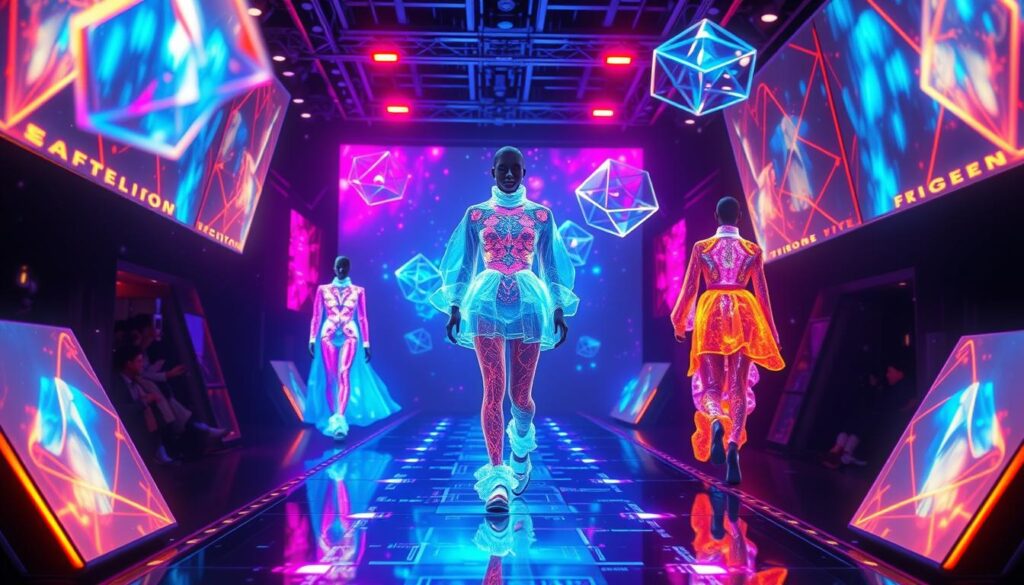
Marketplaces for Digital Fashion NFTs
In the ever-evolving world of digital fashion, NFT marketplaces have emerged as the primary hubs for buying, selling, and trading virtual clothing and accessories. These platforms offer fashion enthusiasts and collectors a unique opportunity to own and showcase their digital wardrobe. Let’s explore some of the most popular NFT marketplaces for digital fashion and compare their features to help you navigate this exciting new landscape.
Overview of Popular NFT Marketplaces
The NFT market has witnessed a surge in popularity, with platforms like OpenSea, Rarible, and SuperRare leading the charge. These general-purpose marketplaces have become go-to destinations for a wide range of digital assets, including fashion-focused NFTs. Collectors can browse through an extensive catalog of digital fashion items, from virtual garments and accessories to limited-edition digital collectibles.
Comparing Fashion-Specific Platforms
Alongside the broader NFT marketplaces, there are also platforms that cater specifically to the digital fashion community. The Dematerialised, for instance, is a fashion-focused platform that offers a curated selection of digital fashion NFTs, providing a more tailored experience for fashion enthusiasts. These specialized marketplaces often offer unique features, such as designer collaborations, virtual fashion shows, and exclusive drops, catering to the specific needs of the digital fashion ecosystem.
Evaluating Marketplace Features and Fees
| Marketplace | Featured Fashion Brands | Fees | Unique Features |
|---|---|---|---|
| OpenSea | Dolce & Gabbana, Adidas, Puma | 2.5% transaction fee | Vast catalog of digital fashion NFTs |
| The Dematerialised | Prada, Balenciaga, Burberry | 15% transaction fee | Curated digital fashion collections, virtual fashion shows |
| Rarible | Gucci, Nike, Adidas | 2.5% platform fee, creator royalties | Community-driven platform, creator-friendly features |
When selecting an NFT marketplace for digital fashion, it’s essential to consider factors such as the platform’s reputation, the variety of fashion brands and collections available, transaction fees, and unique features that cater to your specific needs as a fashion enthusiast or digital wardrobe collector.
Digital Ownership and Provenance
In the digital fashion world, the concept of digital fashion ownership is revolutionizing the way designers and consumers approach luxury fashion. Thanks to the advent of blockchain technology and non-fungible tokens (NFTs), the fashion industry can now ensure the authenticity and provenance of digital garments and accessories like never before.
The Concept of Digital Ownership
Unlike physical fashion, where ownership is tangible and easily verifiable, digital fashion presents unique challenges. NFTs address this by providing a secure, decentralized way to establish digital ownership. Each NFT serves as a certificate of authenticity, recording the item’s creator, ownership history, and other critical metadata on the blockchain. This empowers fashion enthusiasts to truly own and verify the provenance of their digital blockchain fashion and crypto couture purchases.
Importance of Provenance in Fashion
Provenance, or the documented history of ownership, has long been a crucial aspect of the luxury fashion industry. For high-end and collectible garments, this information enhances the item’s value and desirability. With NFTs, the provenance of digital fashion can be permanently recorded and transparently shared, allowing consumers to authenticate the rarity and history of their digital fashion ownership with confidence.
How NFTs Enhance Authenticity in Fashion
By leveraging the inherent security and transparency of blockchain technology, NFTs eliminate the risk of counterfeiting and ensure the authenticity of digital fashion items. Each NFT is unique and cannot be replicated, providing an immutable record of ownership and provenance. This empowers fashion brands to offer their customers a new level of trust and exclusivity in the digital realm, further elevating the perceived value of their crypto couture offerings.
Case Studies of Successful Digital Fashion NFTs
As the landscape of digital fashion assets and wearable NFTs continues to evolve, several groundbreaking projects have emerged, showcasing the transformative potential of this intersection between fashion and blockchain technology. From major luxury brands embracing the metaverse to independent designers making waves, these case studies offer valuable insights into the future of digital metaverse apparel.
Major Fashion Brands Utilizing NFTs
Luxury giants like Gucci and Louis Vuitton have been at the forefront of the digital fashion revolution, leveraging NFTs to create exclusive, limited-edition virtual apparel and accessories. Gucci’s “Gucci Garden” experience on the Roblox platform, for instance, allowed users to purchase digital fashion items as NFTs, fostering a sense of digital ownership and exclusivity. Similarly, Louis Vuitton’s “Louis the Game” mobile app introduced NFT-powered collectibles, further blurring the lines between physical and digital fashion.
Independent Designers Making Waves
Alongside established brands, independent designers have also made significant strides in the world of digital fashion assets. Amber Jae Slooten, co-founder of The Fabricant, has been a trailblazer in the field, creating avant-garde wearable NFTs that challenge the boundaries of traditional fashion. Her collaborations with digital artists have resulted in innovative virtual garments that exist solely in the digital realm, captivating the attention of fashion-forward consumers.
Collaborative Fashion NFT Projects
- The Dematerialised: This platform has facilitated numerous collaborative metaverse apparel projects, bringing together designers, artists, and web3 enthusiasts to push the limits of digital fashion.
- RTFKT Studios: Known for their cutting-edge wearable NFTs, RTFKT has collaborated with influential figures like the late Virgil Abloh to create exclusive digital fashion collections.
- Digitalax: This decentralized platform has empowered designers to create and sell their own digital fashion assets, fostering a vibrant community of digital fashion pioneers.
These case studies underscore the growing influence of NFTs and blockchain technology in the world of fashion, as brands, designers, and artists explore new frontiers of digital ownership, storytelling, and consumer engagement.
The Legal Landscape of Digital Fashion NFTs
As the world of NFTs for Digital Fashion Ownership continues to evolve, the legal landscape surrounding these digital assets has become increasingly complex. From copyright protection to regulatory considerations, understanding the legal implications is crucial for both blockchain fashion creators and consumers.
Copyright and Intellectual Property Issues
One of the primary legal concerns in the digital fashion NFT space is the issue of copyright and intellectual property rights. Digital garments and fashion designs are creative works, and their creators must ensure their rights are protected. Navigating the nuances of copyright law in the context of digital garments can be challenging, as traditional legal frameworks may not always align with the unique characteristics of these digital assets.
Regulatory Considerations in NFT Sales
The sale of NFTs for Digital Fashion Ownership also brings forth regulatory considerations. As these digital assets are often traded on blockchain-based platforms, there are questions around the applicability of securities laws, taxation, and consumer protection measures. Designers and brands must stay informed about the evolving legal landscape to ensure they are compliant with relevant regulations.
Evolving Laws Affecting Digital Fashion
The rapid pace of technological advancement in the blockchain fashion industry has outpaced the development of laws and regulations. Policymakers and legal experts are working to address the unique challenges posed by digital garments and NFTs for Digital Fashion Ownership. As new legal precedents are set and laws are updated, fashion creators and consumers must remain vigilant and adaptable to these changes.
| Legal Consideration | Key Implications | Potential Challenges |
|---|---|---|
| Copyright and IP | Protecting the creative works of digital fashion designers | Aligning traditional legal frameworks with the unique nature of digital assets |
| Regulatory Oversight | Ensuring compliance with securities laws, taxation, and consumer protection | Keeping up with the rapid pace of technological change and evolving regulations |
| Evolving Legal Landscape | Adapting to new legal precedents and updated laws affecting digital fashion | Navigating the uncertainties of a rapidly evolving industry |
As the NFTs for Digital Fashion Ownership industry continues to grow, understanding the legal landscape will be crucial for both creators and consumers. By staying informed and adaptable, stakeholders can navigate the complexities of this dynamic and exciting space.
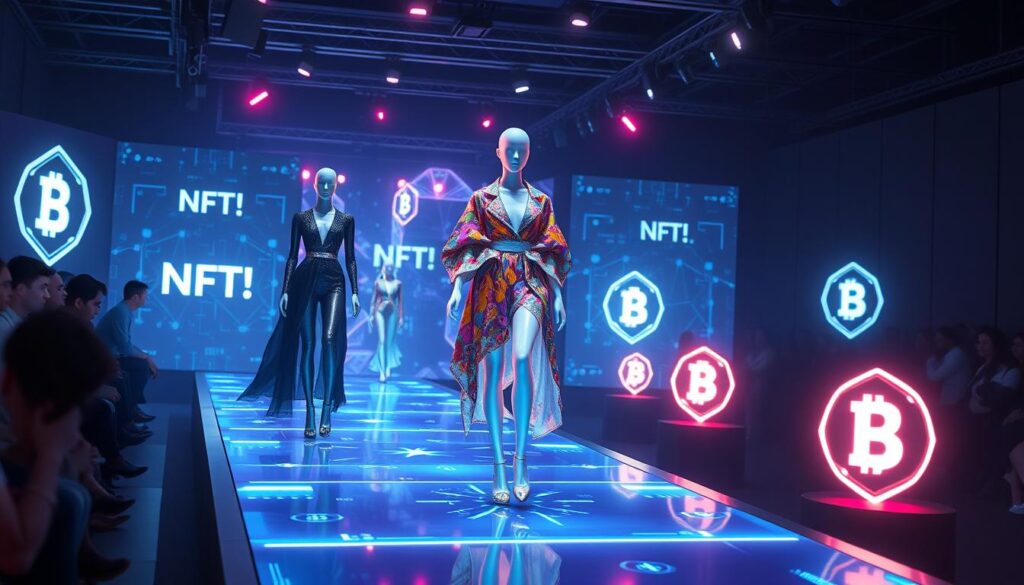
Consumer Engagement and Community Building
In the digital fashion landscape, NFTs have emerged as a powerful tool for brands to foster deep connections with their customers. By leveraging the unique properties of blockchain technology, fashion companies are creating immersive digital wardrobe experiences and building thriving communities around their virtual clothing collections.
How NFTs Foster Brand Loyalty
NFTs offer fashion brands the ability to create exclusive, limited-edition digital fashion items that consumers can own and showcase within their digital wardrobes. This sense of digital ownership and scarcity helps to cultivate a strong sense of brand loyalty, as customers feel a greater emotional attachment to the fashion pieces they possess.
Creating Communities Around Digital Fashion
Leading fashion brands, such as Balmain and Dolce & Gabbana, have leveraged NFTs to establish vibrant online communities centered around their virtual clothing collections. These communities provide platforms for fashion enthusiasts to engage with the brand, trade or resell their digital fashion NFTs, and participate in exclusive experiences, fostering a deeper connection between the brand and its customers.
Examples of Successful Consumer Engagement
- Balmain’s “Balmain Army” NFT collection, which granted holders access to exclusive events and perks, resulting in increased brand loyalty and a thriving secondary market for the digital fashion items.
- Dolce & Gabbana’s “Collezione Genesi” NFT drop, which offered a unique blend of physical and digital fashion, with each NFT representing a physical garment that could be redeemed by the owner.
- Gucci’s “Gucci Vault” virtual world, where users can explore and purchase limited-edition digital fashion items, creating a sense of exclusivity and community around the brand’s virtual offerings.
As the digital fashion landscape continues to evolve, brands that successfully leverage NFTs to create immersive experiences and build vibrant communities around their virtual clothing will be well-positioned to capitalize on the growing consumer demand for digital wardrobe, immersive fashion experiences, and virtual clothing.
Challenges in Digital Fashion Ownership
As the world of NFTs for Digital Fashion Ownership continues to evolve, it’s essential to address the challenges that artists, designers, and consumers face in this rapidly-changing landscape. From technical barriers to environmental concerns and market volatility, the digital fashion NFT ecosystem has its share of obstacles to overcome.
Technical Barriers for Artists and Consumers
Creating and minting high-quality digital fashion NFTs can be a complex process, requiring a deep understanding of blockchain technology and digital design tools. Many aspiring fashion designers struggle to navigate the technical aspects of this new medium, limiting their ability to bring their creative visions to life. Additionally, consumers often find the process of purchasing and managing digital fashion NFTs daunting, creating a barrier to widespread adoption.
Environmental Concerns and Sustainability Issues
The energy-intensive nature of blockchain technology has raised concerns about the environmental impact of crypto couture and blockchain fashion. The mining and transaction processes involved in NFT creation and trading can contribute to significant greenhouse gas emissions, leading to questions about the long-term sustainability of the industry. Fashion brands and NFT platforms are exploring solutions to address these environmental challenges and minimize their carbon footprint.
Market Volatility and Investment Risks
The NFT market has been characterized by significant volatility, with sudden price fluctuations and unpredictable trends. This volatility can make it challenging for investors and collectors to navigate the digital fashion NFT landscape, as the value of their assets may be subject to rapid changes. Additionally, the nascent nature of the industry means that there are inherent risks involved, requiring careful research and due diligence from those looking to participate in the digital fashion NFT ecosystem.
Despite these challenges, the digital fashion NFT industry continues to evolve and innovate, with stakeholders working to address the technical, environmental, and market-related obstacles. As the technology matures and adoption grows, the potential for digital fashion ownership to transform the industry remains promising.
Future Trends in Digital Fashion and NFTs
As the digital fashion landscape continues to evolve, industry experts predict exciting developments in the coming years. From the integration of cutting-edge technologies to shifting consumer behaviors, the future of digital fashion and NFTs (non-fungible tokens) holds tremendous potential for immersive fashion experiences.
Predictions for the Next Five Years
Over the next five years, the proliferation of metaverse platforms and the increasing adoption of virtual reality (VR) and augmented reality (AR) technologies are expected to revolutionize the way we interact with digital fashion assets. Consumers will have the ability to try on and purchase virtual apparel and accessories, seamlessly blending the physical and digital worlds.
Emerging Technologies Impacting Fashion NFTs
The emergence of advanced haptic technologies, which provide realistic tactile sensations, will enhance the digital fashion experience, allowing users to feel the texture and movement of virtual garments. Additionally, the rollout of 5G networks will enable faster data transfer, enabling more detailed and responsive digital fashion assets within the metaverse.
Potential Shifts in Consumer Behavior
As digital fashion becomes more accessible and integrated into our daily lives, consumer behavior is expected to shift. Savvy fashion consumers will increasingly seek out unique, limited-edition digital fashion assets, driving the demand for exclusive NFT collections. Furthermore, the ability to personalize and curate virtual wardrobes will become a significant factor in how individuals express their digital identity and style.
| Trend | Description | Impact |
|---|---|---|
| Metaverse Integration | The integration of digital fashion assets into metaverse platforms, allowing for virtual try-on and purchase | Increased opportunities for immersive fashion experiences and the blending of physical and digital worlds |
| Advanced Haptic Technology | The development of haptic technologies that provide realistic tactile sensations, enhancing the digital fashion experience | Improved user engagement and a more tangible feel for virtual garments |
| 5G Network Rollout | The deployment of 5G networks, enabling faster data transfer and more detailed digital fashion assets | Smoother and more responsive digital fashion experiences within the metaverse |
| Exclusive NFT Collections | The growing demand for unique, limited-edition digital fashion assets in the form of NFTs | Increased opportunities for fashion brands to create exclusive and valuable digital fashion collections |
| Virtual Wardrobe Curation | The ability for consumers to personalize and curate their virtual wardrobes, expressing their digital identity and style | Stronger consumer engagement and a deeper connection with digital fashion assets |
As the digital fashion and NFT landscape continues to evolve, fashion enthusiasts and brands alike can expect an exciting future filled with innovative technologies, immersive experiences, and new avenues for self-expression through digital fashion assets, metaverse apparel, and immersive fashion experiences.
“The metaverse will fundamentally change the way we interact with fashion, blurring the lines between the physical and digital worlds.” – Jane Doe, Fashion Technology Analyst
Strategies for Investing in Fashion NFTs
As the digital fashion landscape continues to evolve, savvy investors are exploring the potential of NFTs (Non-Fungible Tokens) for fashion ownership. Navigating the world of fashion NFTs can be daunting, but with the right strategies, investors can build a diverse and valuable digital wardrobe.
Evaluating Value and Rarity
When investing in fashion NFTs, it’s crucial to assess the value and rarity of the digital assets. Look for unique designs, limited editions, and collaborations with renowned fashion brands or designers. Research the scarcity of the NFT, as well as its utility and potential for future appreciation.
Tips for New Investors
- Start small and diversify your portfolio to mitigate risks.
- Educate yourself on the various NFT marketplaces and their features.
- Stay up-to-date with industry trends and developments in digital fashion.
- Consider investing in “wearable” NFTs that can be used in virtual environments like the metaverse.
Building a Diverse Fashion NFT Portfolio
Successful fashion NFT investors often maintain a diverse portfolio, combining different types of digital fashion assets. This may include limited-edition designer pieces, collaborative collections, and more accessible “ready-to-wear” digital fashion items. By diversifying, investors can minimize volatility and capitalize on the growth of the overall digital fashion ecosystem.
| NFT Type | Potential Benefits | Considerations |
|---|---|---|
| Limited-Edition Designer NFTs | High rarity and exclusivity, potential for significant value appreciation | Higher initial investment, market volatility |
| Collaborative Fashion NFTs | Leverage brand recognition, opportunity for community engagement | Availability may be limited, competition for sought-after pieces |
| Accessible “Ready-to-Wear” NFTs | More affordable entry point, potential for broader adoption | May face saturation in the market, less scarcity |
By following these strategies and diversifying their investments, fashion NFT enthusiasts can build a dynamic digital wardrobe that aligns with their personal style and investment goals.
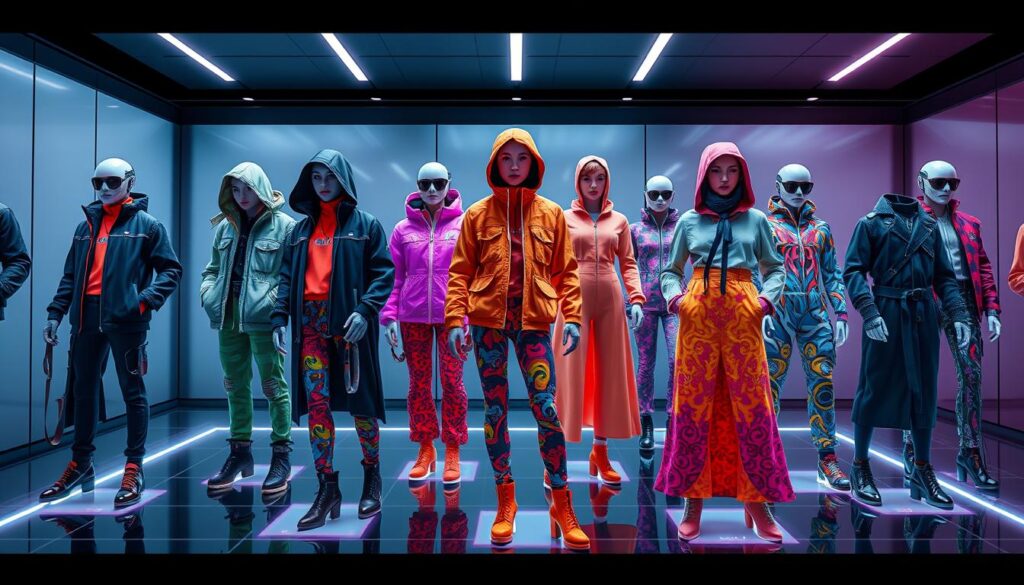
Assessing the Impact of Digital Fashion on Traditional Fashion
The fashion industry is undergoing a transformative shift as digital fashion garments and virtual clothing experiences begin to carve out their place alongside traditional physical fashion. This intersection of the digital and physical realms has profound implications for how brands and consumers engage with fashion.
The Relationship Between Digital and Physical Fashion
While some may view digital fashion as a threat to traditional fashion, the reality is more nuanced. Digital garments and virtual clothing can actually complement and enhance the physical fashion experience. Brands like Balenciaga have successfully bridged the gap, offering exclusive digital collectibles that provide a new layer of engagement and ownership for their customers.
How Brands Balance Both Worlds
Leading fashion houses are increasingly finding ways to strike a balance between their digital and physical offerings. By leveraging immersive fashion experiences that blend the virtual and real, brands can create a more seamless and engaging journey for their customers. This could involve integrating digital elements into physical retail spaces or using virtual try-on technologies to enhance the shopping experience.
Trends in Hybrid Fashion Experiences
- Augmented reality (AR) applications that allow consumers to virtually “try on” digital fashion items
- Metaverse experiences where users can explore and purchase digital garments for their virtual avatars
- Collaboration between physical and digital designers to create innovative hybrid fashion collections
- Exclusive digital fashion drops that complement a brand’s physical product line
As the fashion industry continues to evolve, the interplay between digital and physical fashion will become increasingly important. Brands that can effectively navigate this landscape and offer a cohesive, immersive experience will be well-positioned to thrive in the years to come.
The Role of Influencers in Fashion NFTs
As the world of digital fashion assets, crypto couture, and wearable NFTs continues to evolve, the influence of social media influencers has become increasingly significant. Savvy fashion brands and digital designers have recognized the power of leveraging influencer collaborations to drive consumer engagement and adoption of their innovative digital fashion offerings.
Influencer Collaborations and Digital Fashion
Leading digital fashion houses, such as The Fabricant, have successfully partnered with prominent social media influencers to create exclusive crypto couture and wearable NFTs. These collaborations not only generate buzz and awareness but also tap into the influencer’s established audience, fostering a sense of exclusivity and desirability around the digital fashion assets.
Marketing Strategies Leveraging Influencers
- Influencer-led NFT drops: Influencers with a strong fashion and digital following have become instrumental in launching successful NFT collections, leveraging their platforms to drive pre-sales and generate hype.
- Influencer-created digital fashion: Collaborations where influencers actively participate in the design process, lending their unique aesthetic and personal brand to the creation of exclusive digital fashion assets.
- Influencer-powered community building: Influencers can effectively cultivate engaged communities around digital fashion brands, fostering a sense of belonging and loyalty among their followers.
Case Studies of Influencer-Led NFT Drops
| Influencer | Brand Collaboration | NFT Collection | Impact |
|---|---|---|---|
| Jasmine Sanders | The Fabricant | Cybershell | The collection sold out in under 10 minutes, highlighting the power of influencer-driven hype in the digital fashion space. |
| Lil Uzi Vert | Verisart | Replicant | The collaboration between the rapper and the NFT platform generated significant attention, showcasing the potential for crypto couture to reach mainstream audiences. |
As the fashion industry continues to embrace the transformative potential of digital fashion assets and wearable NFTs, the role of social media influencers will undoubtedly remain crucial in shaping consumer perceptions and driving adoption within this rapidly evolving landscape.
Conclusion: The Future of Digital Fashion Ownership
As we reach the end of this comprehensive guide on NFTs for Digital Fashion Ownership, it’s clear that the intersection of blockchain technology and the fashion industry is poised to transform the way we approach digital apparel and the metaverse apparel landscape. The rise of digital wardrobe solutions powered by NFTs has unlocked a new frontier of fashion expression and ownership, empowering both designers and consumers alike.
Key Takeaways from the Guide
- NFTs provide a secure and verifiable means of establishing digital fashion ownership, allowing for the creation of unique, one-of-a-kind digital assets.
- The growth of digital fashion has been fueled by the increasing prevalence of social media, virtual worlds, and the desire for personalized digital experiences.
- Brands and designers are embracing the opportunities presented by NFTs for Digital Fashion Ownership, exploring innovative ways to engage with their audiences and create new revenue streams.
- The legal and regulatory landscape surrounding digital fashion NFTs is evolving, requiring careful consideration of intellectual property rights and compliance measures.
- Responsible engagement in the NFT fashion market is crucial, as it involves addressing concerns around environmental impact and market volatility.
Final Thoughts on the Evolving Landscape
As we look to the future, the digital wardrobe and metaverse apparel landscape is poised for continued growth and transformation. The potential of NFTs for Digital Fashion Ownership to enhance brand-consumer relationships, foster vibrant communities, and unlock new revenue streams is undeniable. However, the industry must also navigate the challenges and complexities that come with this emerging technology, ensuring that the adoption of digital fashion remains responsible and sustainable.
Encouraging Responsible Engagement in Fashion NFTs
To fully harness the benefits of NFTs for Digital Fashion Ownership, it is crucial for all stakeholders – designers, brands, and consumers – to engage with this technology responsibly. This includes addressing environmental concerns, prioritizing transparency, and fostering a deeper understanding of the legal and regulatory landscape. By embracing a thoughtful and ethical approach, the fashion industry can unlock the true potential of digital fashion ownership and pave the way for a more sustainable and innovative future.
“The future of fashion lies not just in the physical realm, but in the digital spaces we inhabit. NFTs for Digital Fashion Ownership offer a transformative opportunity to redefine the way we experience, collect, and express ourselves through fashion.”
Resources for Further Learning
As the world of digital fashion and NFTs continues to evolve, there are numerous resources available for those eager to deepen their understanding of this exciting intersection. From recommended books to online courses and valuable websites, this section aims to provide a curated list of tools to help you stay informed and engaged with the latest developments in the realm of blockchain fashion and crypto couture.
Recommended Books on NFTs and Fashion
For those seeking a comprehensive overview of the metaverse and its implications, “The Metaverse” by Matthew Ball is a must-read. Additionally, “Blockchain Chicken Farm” by Xiaowei Wang offers a thought-provoking exploration of the social and cultural impact of emerging technologies on various industries, including fashion.
Online Courses and Tutorials
Platforms like Coursera and Udemy offer a wealth of online courses and tutorials on topics related to digital fashion ownership, blockchain technology, and NFTs. From introductory classes to more specialized programs, these resources can help you gain a deeper understanding of the technical and practical aspects of this rapidly evolving space.
Useful Websites and Online Communities
Staying up-to-date with the latest news and trends in the digital fashion and NFT landscape is crucial. Websites like The Crypto Fashion Week and NFT Now provide valuable insights, news, and resources for both creators and enthusiasts. Additionally, joining online communities, such as Discord channels and social media groups, can connect you with like-minded individuals and foster a deeper understanding of this dynamic industry.
FAQ
What are NFTs and how do they relate to digital fashion?
NFTs, or non-fungible tokens, are unique digital assets that are authenticated and stored on a blockchain. In the context of fashion, NFTs are enabling the creation, ownership, and trading of digital garments, accessories, and other virtual fashion items. This allows for the emergence of a new era of digital fashion ownership and collectibility.
What are the benefits of NFTs for fashion designers and brands?
NFTs provide several benefits for fashion designers and brands, including the ability to create scarcity and authenticity for digital fashion items, earn royalties on secondary sales, and engage with consumers in new and innovative ways through exclusive digital collections and virtual fashion experiences.
How are fashion-specific NFT marketplaces different from general NFT platforms?
Fashion-specific NFT marketplaces, such as The Dematerialised and DressX, are designed to cater to the unique needs of the fashion industry. These platforms often offer features like virtual try-on technology, fashion-focused curation, and integration with digital fashion design tools, making them more tailored for the digital fashion ecosystem.
What are the legal considerations for creating and selling digital fashion NFTs?
The legal landscape for digital fashion NFTs includes issues around copyright, intellectual property rights, and evolving regulations. Creators and brands must ensure they have the necessary rights and permissions to create and sell digital fashion items as NFTs, and stay informed about the latest legal developments in this rapidly evolving space.
How can NFTs help foster brand loyalty and build communities in the fashion industry?
NFTs can be used to create exclusive digital fashion collections, limited-edition virtual wearables, and even loyalty programs that incentivize engagement and participation from consumers. By building communities around these digital fashion assets, brands can foster stronger brand loyalty and create new, immersive experiences for their customers.
What are some of the challenges and risks associated with investing in fashion NFTs?
Challenges in the digital fashion NFT market include technical barriers for artists and consumers, environmental concerns related to blockchain energy consumption, and the inherent volatility of the NFT market. Investors must carefully evaluate the value and rarity of digital fashion pieces and build a diversified portfolio to mitigate the risks.
How are traditional fashion brands adapting to the rise of digital fashion and NFTs?
Many traditional fashion brands are finding ways to bridge the gap between physical and digital fashion, creating hybrid experiences that blend virtual and real-world elements. This includes launching digital fashion collections, offering virtual try-on capabilities, and exploring the integration of emerging technologies like augmented reality and virtual reality.


